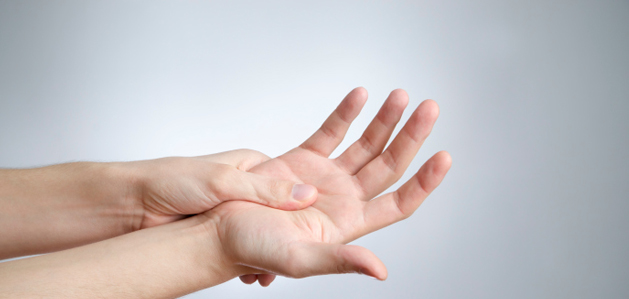I have seen several clients lately complaining about thumb pain or pain at the base of one of their thumbs. In one case, both thumbs. Usually, a physician would explain it as arthritis, or the client has self-diagnosed it as arthritis. The question is, is it really arthritis? Don’t be too quick in thinking that it is arthritis because it may not be. Even if there is some arthritis, there are things you can do to alleviate at least some of the pain. Today I will be talking about that pain at the base of your thumb and how you can reduce, if not, eliminate that pain.
What Causes the Thumb Pain and Stiffness?
When the base of the thumb hurts, gripping things can be very difficult. Making a fist is almost impossible and over time it will just ache all the time. Many have tried creams, wraps, heat, and ice to stop the pain. These are all temporary solutions to the pain. So, let’s dive into how the thumb works and why you have this pain.
At the base of each thumb is a joint called the “saddle” joint. This is the only place on your body that you have this kind of joint. Look down at your hand and move your thumb in and out. Do you see the triangular shaped area between the index finger and thumb? Now feel that same area. In some cases, this area can be very sore, while for others not so much. As you get closer to the base of this triangular area, the pain can increase dramatically. You have a muscle in that area named the Thenar eminence. It attaches to the index finger and wraps around the lower bone of the thumb. The Thenar eminence allows you to grip things and move your thumb in every direction so you can hold on to most things that most animals would find difficult to do.
We use our thumbs for nearly everything we do with our hands. Gripping a door handle, steering wheel, chef’s knife, or gym equipment. Virtually everything we do with our hands requires using the thumb. So it is no wonder we have so much pain there. Unfortunately, we do not take care of our thumbs as much as we should.
It’s the Use Not the Age
The first mistake is we assume the pain is only because we are older, and there is some truth to that, but it’s not just your age. It has more to do with what you do with your thumb and how well you prepare your thumb for the tasks ahead. Many professions hurt the thumbs just by the way the thumbs are used in performing the work. Dentistry, surgery, typing, massage therapy, carpentry, or anything else that requires us to use our hands with small instruments or pressure from our hands. Cooking is very hard on the thumbs and hands as we prepare our food each day. Most thumb pain is from overuse. The more you use it, the more the Thenar eminence hardens, putting pressure on the saddle joint at the base of the thumb. Over time it will become more difficult to hold things without pain, and without feeling weak.
What I have seen over time is the thumb will move closer to the index finger, then stick out like a horn. The webbing between the index finger and the thumb gets shorter and shorter over time with use. This will cause the saddle joint to rust and arthritis may set in, making it painful to move. The secret here is, we need to extend that webbing between the index finger and the thumb so we can lubricate the saddle joint and free the thumb.
How to Resolve the Thumb Pain or Stiffness
Like I said earlier, most have tried creams, wraps, pills, heat, and ice. All of these are temporary fixes. As it gets worse, and looks worse, you may have tried pulling the thumb out by grabbing on to the end of the thumb. Good idea, but it will make your thumb look more like a horn since you are not moving the saddle joint. For some reason, I see this more in women than men, not sure why, though. Sadly, many people just give up and succumb to the idea that it’s just a fact of aging.
There is hope in resolving this thumb pain. Each day use your opposite hand and squeeze that area between the index finger and thumb, the Thenar eminence. Don’t squeeze too hard as the pain may be too much, at first. Gently squeeze in the beginning and increase the pressure as it becomes more tolerable. Squeeze just hard enough that allows you to still breathe. As you squeeze that area, breathe out, and allow the muscle to relax. As the pain subsides, move to another area and repeat. Do this all over that area every day, several times a day at first. I would squeeze from the top and then underneath that area.
You can stretch that area and I will place the two videos below. The first stretch is working to stretch the webbing between the index finger and thumb. The key here is, place the thumb of the opposite hand at the base of the painful thumb. Wrap the other four fingers around the painful thumb. For some, both thumbs are painful, so I use the term “intended thumb” to refer to the one you’re stretching. Gently pull the thumb out as you brace with the thumb of the opposite hand at the base of the intended thumb. The focus here is stretching the webbing between the index finger and thumb. Do not worry about how far it moves. Just move it and the range will take care of itself. Again, the key here is using the opposite thumb at the base of the painful thumb as a brace for leverage.
The second one is a little more complicated as the placement of the hands is key. Look at the hand that you want to stretch. Turn the thumb up towards the ceiling. Now place the opposite hand across the hand you are stretching so the painful thumb you want to stretch is between the four fingers of the opposite hand and the thumb of the opposite hand. Make sure both hands are rigid and not limp. Keeping the opposite hand stiff, lift the wrist of the opposite hand which will apply pressure to the painful thumb and move it back across the hand. Do not overdo this as the pain will be too much. Be gentle and feel the base of the painful thumb stretching a little. Breathe out as you stretch and allow the thumb to just let go. I would do this every day for the rest of your life. You can do these anywhere, anytime in most cases.
Take your time with both of these stretches as it can be a little challenging in the beginning, but practice makes perfect. As you all know I use my hands daily working on most of you. Many therapists complain of hand pain and some even retire early due to hand pain. I do these stretches every day and my hands never hurt. It can improve yours, too. Set aside a few minutes a day and just do them so you can enjoy your day without pain.
Tips to Improve Your Stretching
All you need is a yoga strap and a tennis ball for the tennis ball massage. Give yourself about 15 minutes twice a day and you should see better results within 2 weeks. This, though, is a lifetime event. Think of your pet. they stretch every day and several times a day. Stretch when they stretch. Follow the videos below and free your knees. In my opinion, the calf stretch is the most important stretch a human can do. It will solve many issues of the body.
Stretching is more about feeling the muscles letting go than forcing them to stretch. If you are forcing the muscle, you could be doing strength training, not stretching. Make sure you are feeling the intended muscle stretching. If not, the form could be wrong. Holding for 5 seconds allows the brain to release the muscle before it senses any danger. Repeating the stretches 10 times allows the brain to learn it is safe for the muscle to move that way.
Don’t Forget the Tennis Ball Massage!
Softening your hips and back is easy when you use the tennis ball. Just lean against the wall and apply enough pressure to feel the painful area. The temptation is to press harder but resist it. Instead, breathe out and allow the muscle to soften under the ball. Then move to another spot and repeat. Continue doing this until most of the painful spots are gone. Check out previous newsletters to see the video.
If you like this article, please share with your friends and family. Don’t forget to check out our social media pages, leave a comment, and as always, reviews are awesome!
Want to Talk with Me Directly? Start Here
We’re happy to offer you a complimentary 30-min virtual consultation so you can experience this for yourself. Schedule your introduction to Stretch n Release now.
About The Muscle Repair Shop
Drawing upon his personal experience as a former competitive athlete turned wheelchair, obese, and chronic pain sufferer, Muscle Repair Shop Founder Butch Phelps decided to take his health into his own hands when at the age of 36 he was told he might not make it to his 40th birthday. Applying balanced nutrition advice from his doctor along with a sound exercise program, he went from 315 lbs. to 180 lbs. Motivated by his experience, he then acquired degrees in advanced therapeutic massage and aging sciences to help people eliminate chronic pain. This included applying his expertise in how people age, including the effects of dementia, anatomy, psychology, and the day-to-day struggles living as an older person to his practice and development of The Muscle Repair Shop’s one-of-a-kind Stretch n’ Release Technique.
Available through in-office and virtual coaching treatment sessions, this unique combination of stretching and breath work teaches the brain to release the emotional side of muscle tension and pain allows clients to find lasting relief and healing from stiffness, aches, injuries, and chronic pain. The at-home exercises come with customized instructional videos and virtual or in-office support, allowing clients to enjoy and experience life and sports as they did before limitations slowed or curtailed activities.


